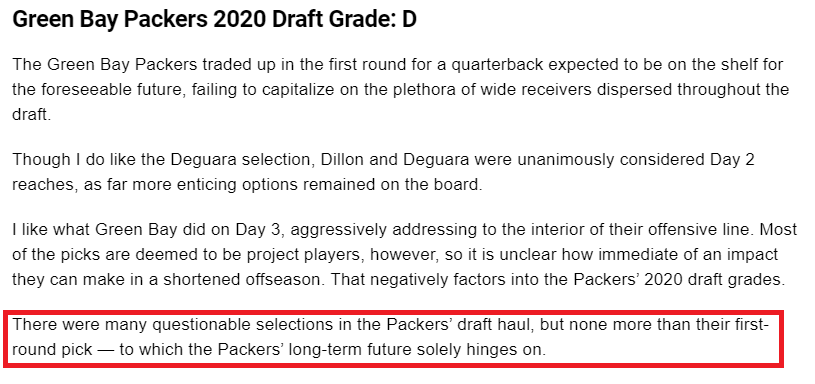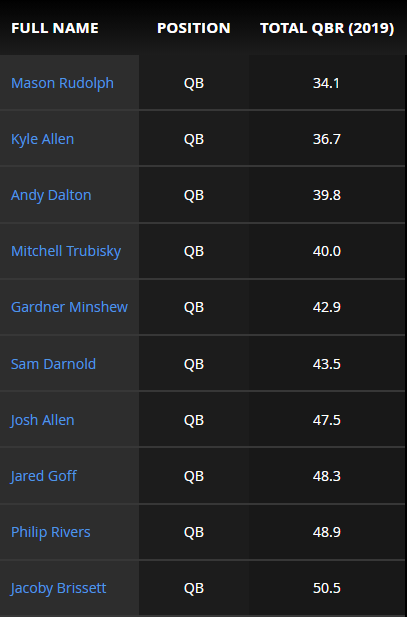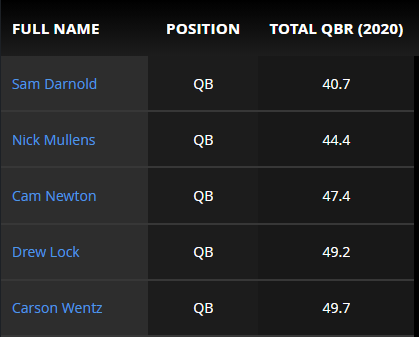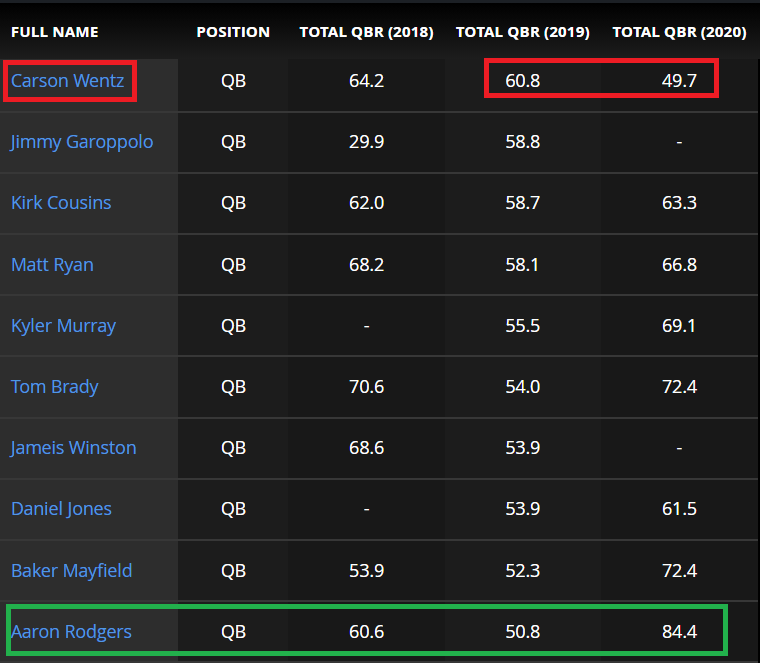April 23rd, 2020. The NFL Draft was held via videoconferencing thanks to the COVID-19 pandemic. As the end of the first round approached, the Green Bay Packers made the most shocking move of the night: selecting quarterback Jordan Love while future Hall of Fame quarterback Aaron Rodgers had four years and $53 million in guaranteed money left on his contract.
To this day, this move is mocked and ridiculed. Rodgers, when healthy, had made the Pro Bowl every season since 2011 and had thrown 51 touchdowns to six interceptions in the past two seasons combined. Why would the Packers do to Rodgers what they had done 15 years ago to the former Packers starting quarterback, Brett Favre? Today’s Meet The Metric, Total QBR, provides insight into this franchise-altering move.
What’s Total QBR and Is It Fantasy-Relevant?
From the PlayerProfiler glossary, Total QBR was developed by ESPN’s Stats & Information Group. It’s a way to measure a quarterback’s “clutch factor.” It rewards quarterbacks for plays that contribute to scoring points and winning games. Plays that affect win probability contribute to a quarterback’s Total QBR.
It’s not a relevant stat in predicting a quarterback’s fantasy football success. For example, in 2020, Drew Brees‘ 74.5 Total QBR ranked No. 6 among qualified quarterbacks, but he finished the season averaging 18.0 (No. 15) Fantasy Points Per Game. Ryan Fitzpatrick was No. 5 in Total QBR with a 77.3 mark, but that didn’t stop the Dolphins from benching him for their 2020 first-round quarterback, Tua Tagovailoa.
Total QBR is more relevant in dynasty football leagues. Dynasty requires paying attention to advanced stats and metrics that predict what a team may do at a position. Josh Larky’s Expected Points Added (EPA) was one example of a metric that measured a player’s ability to help NFL teams win games, and so is Total QBR. Quarterbacks with low ratings in their Total QBR metric are likely replaced sooner rather than later.
Understanding the Jordan Love Draft Pick
Despite only throwing four interceptions in 2019, Aaron Rodgers finished the season with a 50.8 Total QBR. Only 10 quarterbacks finished with a lower Total QBR. Josh Allen, Sam Darnold, and Mitchell Trubisky benefitted from being young, first-round quarterbacks that would be given opportunities to turn it around. Allen would reward the Buffalo Bills’ patience and faith in him and finish 2020 with an 81.6 (No. 3) Total QBR. The other two quarterbacks weren’t as fortunate and their teams moved on from them the following offseason.
Kyle Allen and Mason Rudolph finished with the two-lowest Total QBR scores in 2019, solidifying their statuses as backup-caliber quarterbacks. Jared Goff and Gardner Minshew spent the following 2020 seasons with their teams openly discussing upgrading the positions and were replaced by other quarterbacks. Andy Dalton, a nine-year starting quarterback for the Cincinnati Bengals, has been relegated to a journeyman quarterback.
Philip Rivers entered the NFL the year before Rodgers. The Chargers, a bottom-tier team in the 2020 NFL Draft, had no choice but to move on from their 15-year quarterback, but struck gold with Justin Herbert. Rivers signed with the Indianapolis Colts to replace Jacoby Brissett, the tenth and final quarterback. It’s possible that the Packers saw parallels in their situation compared to the Chargers and opted to be a year early transitioning from a franchise quarterback rather than a year late.
Hindsight is 20/20, but only Rodgers’ obsessive fans predicted what happened in 2020. Brian Gutekunst, the Packers’ GM, saw the Rivers situation and tried to get ahead of the curve. With a chip on his shoulder the size of Gutekunst’s balls on April 23, 2020, Rodgers would win league MVP. He led the league with an 84.4 Total QBR and threw a career-best 48 touchdowns.
What Can 2020 Total QBR Tell Us About 2021 And Beyond?
Four current starting quarterbacks finished 2020 with a Total QBR under 50.0. Cam Newton’s removal became imminent when the Patriots drafted Mac Jones. Producing a 73.9-percent (No. 35) Catchable Pass Rate cannot be excused by a -3.97 (No. 22) Supporting Cast Efficiency rating.
Drew Lock dodged a bullet in the 2021 NFL Draft when his team passed on Justin Fields. Now, Denver is a favorite to land Aaron Rodgers if the Packers trade him. Sam Darnold has three consecutive seasons with a sub-50.0 Total QBR. His leash is still short, despite joining a new team. The Panthers will be quick to move on from him if he doesn’t improve.
https://youtu.be/w-izrUbJxhM
Carson Wentz had a 33:7 touchdown-interception ratio back in 2017 and was an MVP candidate before tearing his ACL. With Frank Reich as his offensive coordinator, Wentz had a 75.8 (No. 3) Total QBR in 2017. Reich would leave for the Colts’ head coaching job and Wentz would struggle in his absence. If there’s one quarterback in the group who can turn around his Total QBR like Rodgers did last season, it’s Wentz.
Before his 2020 MVP season, Rodgers saw his Total QBR dip from 60.6 (2018) to 50.8 (2019). Wentz’s Total QBR dipped from 60.8 (2019) to 49.7 (2020). Wentz has job security that Rodgers had last year. Jordan Love wasn’t ready to play in an unusual season. No current Colts quarterback has taken an NFL snap. A change in scenery and play calling can alter a career; ask Ryan Tannehill, who finished 2018 with a 35.0 (No. 37) Total QBR. In Tennessee, it would increase to 62.5 as a part-time starter in 2019. In 2020, his 78.7 Total QBR was the No. 4 showing.










